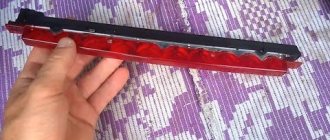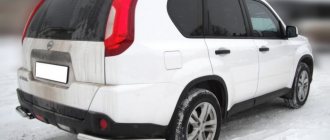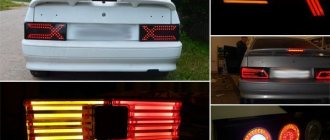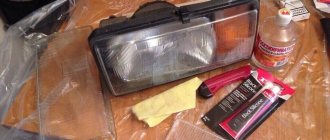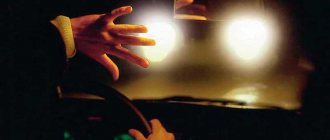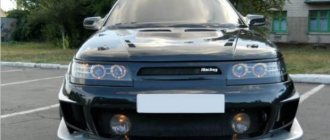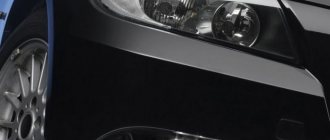Tuning Bleeding optics Do-it-yourself xenon installation - a practical guide
Xenon is an inert gas that is odorless, tasteless and colorless. One of its features is that when an electric current is passed through it, this gas becomes a powerful source of light. There are several reasons why xenon has gained immense popularity among car enthusiasts.
Xenon lamps produce very bright daylight, and this is more familiar to human vision. They have high light output and allow a wider view of the road in front of the car.
Xenon lamps are durable, very economical and resistant to physical influences. In addition, they are quite easily installed in cars instead of standard lamps. It is this process that we will look at below.
What is the difference between xenon and bi-xenon for cars
The main difference between xenon and bi-xenon is the operating mode. Xenon works only in one way - low beam, which is why it is not enough. This is especially noticeable when driving at night at high speed on a country road. Bi-xenon operates in two different modes: low beam and high beam.
Switching between low and high beam is carried out by changing the position of the arc. This is achieved by installing special movable electrodes in the lamp. They change their position on command given by a special regulatory component. The design of a xenon lamp involves fixing the arc. It is impossible to change the position.
When choosing between xenon and bi-xenon, the following points should be considered:
- difference in design;
- view of the headlights pre-installed in the vehicle.
In modern cars, bi-xenon is used more often
Vehicle headlights can be divided into two main types:
- when only one lamp is mounted, it operates in the near/far mode;
- Each glow mode has its own light source.
This is interesting: Replacing a car steering wheel yourself
Rules for setting xenon headlights
Incorrectly installed xenon blinds oncoming drivers and easily leads to accidents
To avoid dazzling drivers of oncoming cars, it is necessary to correctly configure xenon and bi-xenon immediately after installation. The procedure is carried out as follows:
- The car is placed with the hood against the wall, parallel to it - the distance between it and the bumper should be minimal.
- Using chalk, a felt-tip pen or something similar, it is necessary to mark the center of each of the headlights and the car itself (the marks should be perpendicular to the bottom border of the wall);
- The car must be rolled back 7.5 meters from its original position.
- After this, draw a horizontal line through the center of the light beam of the lamps using chalk on the wall.
- Next, another horizontal line is drawn (also on the wall with chalk) - it is parallel to the previous one and should be 7.62 cm lower.
- Then the low beam of the car is turned on and, using special adjustment bolts, the optimal position of the light beam is determined - the upper part of the central beam should touch the lower horizontal line.
Is it legal to use bi-xenon in the Russian Federation: GOSTs and requirements of the Administrative Code
It is necessary to focus on the document “On the use of xenon headlights”. It was formulated by the Security Department of the Ministry of Internal Affairs of the Russian Federation on February 20, 2010. In accordance with it, it is allowed to install headlights with the following range designations on cars:
- GOST R 41.112–2005 (direct incandescent lamps): C - low;
- R - long range;
- CR - headlights operating simultaneously in two modes;
- HC - near;
- DC - near;
If there is a need to replace conventional incandescent or halogen lamps with xenon, you should carefully read the state standards. This way you can avoid a significant fine. The situation is similar with PTF (fog lights). These lighting fixtures are not required. Fog lights are subject to the same requirements as standard headlights.
In the worst cases, for incorrectly installed xenon, you can say goodbye to your license for six months
When installing xenon or bi-xenon headlights not intended for this purpose, liability arises, regulated by Part 3 of Art. No. 12.5 Code of Administrative Offences. If traffic police officers establish the use of such equipment, the driver’s license may be confiscated for a period of 6–12 months. The lamps themselves will be confiscated, but there will be no fine.
Do-it-yourself xenon installation on a car
Car headlights at night and in the evening are the driver's eyes. Without the work of the light elements, it simply will not be able to move along the road. Driving without headlights is like being in a dark room blindfolded. The safety of driving a car at night depends 90% on the proper operation of the low and high beam headlights. Automakers are increasingly paying attention to the quality of headlights and are working to improve light transmission.
High-quality road lighting reduces the likelihood of a traffic accident several times. Traditional headlights are used less and less with each new car that comes off the assembly line. The era of halogen, xenon and bi-xenon headlights has arrived. These are completely new solutions in the world of automotive lighting elements. The most widely used are xenon headlights, which enjoy real “people's” love.
Video “Illustrative example of xenon installation”
The video below provides detailed and visual instructions for installing xenon lighting using the example of a Hyundai Accent car (the author of the video is the Parking channel).
Similar articles
Legal xenon - myth and reality: recommendations of the servants of Themis
Xenon in fog lights without deprivation of rights and a fine: when you can’t, but really want to
Low beam lamps are the most important element of automotive lighting
Optima xenon lamps on the automotive lighting market: what should you know?
What is xenon?
Xenon is one of the inert gases, which is quite rare. Its name is translated from Greek as “stranger.” Approximately one century after the discovery of this gas, it began to be widely used in automotive lighting.
To install xenon, you need to slightly change the electrical circuit of the machine. The car must be equipped with a high-voltage unit, since in order for such a lamp to turn on, a discharge with a power of about 25 thousand volts is required.
The installation of xenon in Russia is permitted on almost all types of vehicles equipped with halogen headlights. One of the main advantages of xenon light is its efficiency, which is significantly superior to halogen lamps. Once you experience what it's like to drive with xenon on, you will no longer want to use standard lighting options.
Types of xenon: h1, h4, h and others
All light sources are divided into different types according to the type of base. Car headlights are equipped with flanged lighting components. They have a spiral tolerance on the flange itself. For example, lamps of type H1, H7 are characterized by the following configuration:
- the spiral itself is folded as compactly as possible;
- the spiral is stretched to its maximum length along the optical axis of the reflector.
Interchangeability of halogen and xenon lamps
There is a special standard for PTF headlights. The spiral is usually located perpendicular to the optical axis. Lamps for fog lights are marked as H3. A special, rarely encountered standard is R2. It is used in outdated two-headlight systems. Most vehicles today are equipped with H1 and H7 lamps.
An equally popular standard is H4. They are used in many mid-priced vehicles. A distinctive feature is the ease of installation, replacement and adjustment if necessary. The main disadvantage of such a lamp is its relatively low light output.
What light bulbs do experienced drivers recommend installing?
Important factors are cost, as well as the brand of specific equipment. If possible, you should not save money; it is recommended to purchase xenon/bi-xenon from well-established brands. The most well-known manufacturers in this segment of automotive equipment are:
- MTF-Light is a reliable brand from South Korea (you can purchase lamps with blocks, as well as bulbs from Philips);
- Sho-me is also a Korean manufacturer of budget xenon optics for a relatively low price;
- Matrix is a little-known manufacturer, the cost of products is slightly above average, the quality is at a fairly good level (Taiwan);
- IPF - according to consumer reviews, the company offers the highest quality xenon of all existing ones (Japan);
- Optima - offers high-quality lamps at low prices (China);
- Interpower is a Chinese manufacturer that produces a relatively high-quality product at a low cost.
Product examples (photo report)
The optimal solution is to purchase xenon or bi-xenon from the Japanese company IPF. At the same time, there are many budget alternatives. You should avoid purchasing “noname” (“gray”) products. This term means xenon (lamps, etc.) without brand designation, marking, or country of manufacture. Installation of non-standard lighting equipment may result in revocation of rights.
This is interesting: Washing the engine with your own hands
Example of step-by-step installation of bi-xenon lamps
Installing bi-xenon is most relevant for owners of old cars. The installation process on a Lada 2108 export 1.6i turbo is as follows.
- You should unpack the box and check that all the necessary components are present - usually a pair of lamps, two ignition units and connecting wires;
Check the completeness on site!
- In accordance with the connection diagram, it is necessary to connect the electrical wiring and the bi-xenon kit itself: brown wire - negative;
- white - near;
- blue - distant.
Use the diagram when connecting
Xenon connection diagram
The hole should not be too large
All that remains is to install the ignition units
Ignition units may be sold separately
In the example, a place for the block was found at the washer reservoir
Much better than standard optics
It is important to remember to fine-tune the type of lighting in question. If you do not have such experience, you should contact specialists at a car service center. In most cases, the necessary actions are simply impossible to carry out without special measuring scales. If possible, you should carefully read the video before installation.
How to connect yourself: video tutorial
Bixenon
In order not to install two different xenon kits for low and high beam, you can simply buy and connect bi-xenon. Bi-xenon lamps have the same principle of working with inert gas, only they are also equipped with an additional electromagnet. It is this that allows you to switch the headlights to low and high beam.
Installing bi-xenon has some nuances. Let's take a closer look at the connection process.
1. We connect the wires from the bi-xenon lamps to the ignition unit.
2. We connect the controller wires to the same block. He is responsible for stabilizing the voltage throughout the wiring.
3. The bi-xenon lamp has an additional wire responsible for the electromagnet. It should also be connected to the controller.
4. We connect the controller to the battery.
Features of selection and installation
There are a number of features and the most important criteria for the selection and installation of these lamps. The most frequently asked questions are covered below.
Choice depending on the geometry of the headlights (lensed, corrugated, etc.)
Today, if xenon is installed in headlights not intended for this purpose, special focusing lenses must be additionally mounted. In this case, the setup must be carried out in a certified car service center. Otherwise, there is a high probability of a mistake and you could easily be deprived of your driver's license.
Headlights with complex geometry are equipped with bi-xenon lenses in a car service center
What is a snag and how to install it correctly
Xenon consumes significantly less electrical energy than halogen lamps. Therefore, the on-board computer can identify its installation as a lamp burnout - the circuit automatically turns off. This is exactly how everything works, for example, on the Opel Astra. The problem can be avoided by installing a capacitor in the circuit, which is called a blende. Thanks to it, the computer “does not notice” the absence of a corresponding load on the network. To install, the capacitor must be built in series into the wiring directly in front of the lamp.
Installation example next to the ignition unit
Is it possible to connect via a capacitor?
On some brands of vehicles, after installing xenon, power failures occur. This can be avoided by installing a special capacitor. It is mounted parallel to the main supply line. This allows you to smooth out the voltage drop when dips occur.
How to put a switch on a separate button
It is often necessary to turn on xenon with a separate button. Carrying out this procedure is not difficult. It is enough to install a two-position switch in the cabin, and then connect the line break to it.
What to choose: Video test of the most popular ignition units (in 2 parts)
Required tools and materials
Before installation, you must obtain the appropriate tools:
- construction hair dryer;
- car repair kit;
- stationery knife;
- wire cutters;
- insulating tape;
- a pair of 4-pin relays;
- xenon kit with ignition units and lenses.
In addition to the kit and tools, you need to familiarize yourself with the general principles for installing such light sources:
- Lenses are an essential part of xenon installation. Such a light source is too bright, and the beam of light must be collected and evenly distributed over the road surface. If you put a xenon lamp in a simple halogen reflector, the installation will not provide good light, and oncoming drivers will be blinded. The lens for xenon and halogen is different.
- Working headlight range control. If you load the car, the front end will rise and begin to blind oncoming drivers. The beam of light must be lowered down to maintain the correct cut-off line. Many GOST standards provide for the use of an automatic corrector.
- Washer. Dirty lenses will not provide good illumination, and the light will be scattered across the surface of the headlight glass. Thus, oncoming drivers will again be blinded. The headlight washer must be additionally mounted in the bumper.
General information about xenon
Before you independently install xenon on your own car, you need to have a general understanding of xenon optics. Xenon is an inert gas that is currently actively used in the production of automobile headlights. While in Europe there are certain restrictions on the use of such optics, in Russia any type of xenon lamps can be installed.
What xenon headlights are is explained in the video:
Using xenon provides several advantages:
- Increased lighting efficiency, significantly superior to traditional halogen headlights.
- High power, while in order to protect against dazzling oncoming drivers, headlights must be installed at a certain angle of inclination together with correctors that change the angle of inclination of the optics when driving on uneven areas.
- Duration of operation. On average, xenon lamps have ten times longer service life compared to halogen lamps.
Types of xenon
The brightness and color shade of the lamp depends on a parameter such as temperature. The color range of xenon varies from yellow to violet. Temperature is measured in degrees Kelvin. More saturated colors are rarely used by car enthusiasts; most often they install white xenon, it looks more like daylight. The yellow color of the headlights will be at 4050 K. And the white color is equal to a value of 5000 K. The blue tint is obtained at 6000 K, and the purple tint at 18000 K.
Also, xenon lamps come in different sizes. To choose the right size lamp for your headlight, you should take an old one for comparison. The durability of the lighting elements is quite high, so replacing xenon lamps will be done very rarely.
Also, every car enthusiast needs to know that pseudo-xenon is available for sale. It has nothing to do with xenon lamps. These are ordinary halogen lamps, tinted blue with a higher wattage. So when buying xenon you need to be very careful.
What is xenon in a car and is it allowed to install it yourself?
A special feature of xenon lamps is the absence of tungsten filaments inside them. In such a light bulb, the special gas pumped into it, xenon, is heated.
This type of lighting has a lot of advantages, the main ones being the light that is as close as possible to daylight and a long service life, and certain disadvantages - in conventional headlights that are not designed for this purpose, xenon light blinds oncoming drivers.
In addition to the xenon lamps themselves, you will also need to install high-voltage units (popularly called “ignition units”), because igniting the xenon inside the lamp requires a voltage of up to 25,000 Volts, which no car battery is simply capable of providing.
Is self-installation of xenon allowed?
Whether it is possible to install xenon yourself or not is a controversial issue. After all, you can get a fine for unauthorized installation of non-standard optics. So, before you start acting, it is better to clarify the situation with the traffic police officers, because few people want to pay money for a xenon kit, spend a lot of time and effort to install it, and at the same time make additional problems for themselves.
The thing is that the traffic rules do not clearly indicate that xenon is prohibited. However, the Decree of the Government of the Russian Federation No. 720 of September 10, 2009 “On approval of technical regulations on the safety of wheeled vehicles” states that no changes to the braking system, lighting devices and steering are allowed. Therefore, before purchasing xenon and installing it on a car, you should think carefully.
Those same car enthusiasts who doubt the legality of installing xenon lights in standard headlights can go the other way - install xenon in foglights, which is allowed even according to the above technical regulations.
Advantages of xenon lamps
It is better to buy branded xenon kits; you should not skimp on improving your own car. Let us list the main advantages of good xenon.
1. The lamp ignition time is very short. The approximate time is about 3 seconds.
2. Very long period of use.
3. There is a short circuit protection circuit.
4. Getting rid of a break in the electrical circuit.
5. High light output.
6. Stable light flow: it will not scatter in different directions.
7. Energy efficiency is very high. Xenon lamps consume 40 percent less electricity.
8. The car network is not overloaded.
9. Does not tire the driver's vision.
This number of advantages is enough to avoid buying Korean or Chinese analogues. Such models have a short service life, and the ignition time is 20 seconds. The lamps can cause electrical interference and, when heated, vaporize the silicone or adhesive they are attached to. The reflector quickly becomes unusable (covered with a white coating).
This article fully discussed the correct installation of xenon with your own hands. If you have free time and a great desire to install xenon in your car, then it’s time to get to work. The effort you put in will be worth the stunning appearance of your car.
Below you can watch a video on how to install xenon with your own hands.
Safety precautions when installing xenon
During the installation of xenon, some difficulties may arise, so you should be prepared for complications:
- Work must be stopped immediately in cases where there is obvious damage to lamps, ignition units or wires.
- Before installation, you must wash your hands thoroughly, because greasy, oily or wet fingers can not only render the lamps unusable, but also increase the risk of electric shock.
- All wire connections must be carefully insulated with high-quality electrical tape, because contact with water can lead to a fire.
- It is not recommended to look at working xenon headlights for a long time, as there is a possibility of damaging your eyesight. This can only be done with tinted glasses.
- Before installation, be sure to degrease the lamp bulbs using a cloth and alcohol.
As you can see, installing xenon is not such a difficult undertaking, and you can do it yourself. You just need to take this issue seriously and follow our recommendations step by step.
How to install xenon headlights="ltr">
To understand how to properly install xenon, we carefully prepare.
Correct installation is divided into several stages:
- Installation of xenon bulbs:
Installing xenon with your own hands is a fairly simple process, but it will require careful handling and concentrated attention. You will need to:
- sequential installation of lenses, and then installation of the ignition unit;
- connecting electrical cables, as well as connecting devices to the main electrical circuit.
When we get started, be sure to stay safe. To start working, a xenon lamp will require a current exceeding 20,000 V! Therefore, first we remove the battery terminals, then remove it entirely.
ATTENTION! Do not touch the xenon lens shell with your hands. Once you have already touched it, wipe it very carefully with alcohol and a clean, soft cloth.
Remove the protective cover from the headlight unit. Disconnect the wires from the terminals of the base lamps and pull them out. Sometimes they can be pressed using a locking spring; it needs to be pressed out.
We slowly pull out the xenon lamp, without touching the lens shell, and put it in the place where the old one was. We do the same with the second lamp. If you had to release the spring, return it to its original state.
- Installation of ignition units
Correct installation of these parts takes into account the following:
- they must be placed not far from the headlight, so that after the lamps are connected, the wires are not strained and there is a possibility of reliable fastening;
- the location must be inaccessible to dirt, moisture or heat;
- The basic mounts in a set of xenon lamps must be placed on a static and durable surface.
- Assembling the electrical circuit
When the xenon bulbs and ignition are installed, we connect their contacts using wires. Each of the wires and the corresponding terminal has its own color, so it will be problematic to confuse the connections. We connect the ignition unit to the car's electrical circuit using the connectors of the base lamps that were installed before.
We make sure that we have not made any mistakes using the instructions. If everything is correct, we secure the entire bundle of wires with clamps so that they do not have the opportunity to dangle. Carefully roll the extended cords into a ring and secure them.
If the car's wiring has a connected on-board computer, problems may occur when installing xenon optics at the ignition stage due to a sharp increase in current load. Then we install an additional voltage relay so that it equalizes the load on the electrical wiring of the machine.
How to install xenon lamps
To install xenon with your own hands, study the picture below. It demonstrates the principle of connecting a xenon headlight:
You can see that the connection point in the “native” lamp supplies energy to the ignition unit. The lamp is supplied with a modified high voltage coming from the unit. When installing bi-xenon devices, the diagram is similar to this one, since the electromagnetic parts are located inside. Any kit sold will include exact installation instructions with this wiring diagram. Before installing bi-xenon, you need to study it thoroughly, because each company’s devices may have individual characteristics during the connection process.
Xenon installation instructions
The process of installing xenon with your own hands, instead of standard car lighting, is simplified year after year. And if earlier for this it was necessary to significantly change the wiring in the car, use special adapter rings and other devices, today it is enough to make a decision regarding 2 points:
- Lamp type - it can be xenon or bi-xenon;
- Base type - to simplify installation, xenon lamps must be purchased with the same base as the standard halogen lamps installed in the car from the factory.
In some cars, the optics are designed in such a way that the high and low beam bulbs are separated. In this case, installing bi-xenon is impossible - only xenon. In other cases, you can install bi-xenon, and then switching from low to high beam will occur in one lamp.
A xenon kit for installation on a car must include the following components:
- Ignition blocks – 2 pcs.;
- Xenon lamps – 2 pcs.;
- Fasteners (required for installation);
- Set of wires;
- Installation and connection instructions.
Typical xenon (bi-xenon) connection diagram
To successfully install xenon with your own hands, it will be enough to follow the instructions that come with each kit. The main thing is to strictly follow the sequence of actions described in the instructions and safety precautions.
Below we provide a step-by-step guide to installing and connecting xenon, compiled by our specialists. For detailed video instructions, see the end of this article.
And so, the sequence of actions performed when installing xenon will be as follows:
- Removing the old lamp . To install xenon lights, you first need to remove the old halogen lamps from the headlights. To do this, remove the plastic protective cap that covers the base on the back of the headlight, and, pressing the metal clip, remove the old light bulb from the socket.
- Installing a xenon lamp . In place of the old one, it is necessary to install a new xenon lamp (previously removed from the transport packaging) into the headlight and secure it with a spring clip.
- Connecting contacts . Observing the correct polarity, connect the power contacts from the old lamp to the terminals from the new one. Carefully insulate the connection points of the wires with electrical tape or heat-shrink tubing.
- Laying wires . As a rule, the protective caps that cover the bulb sockets on the back of the headlight do not have any holes. To lay the wires in each cap, you need to use a construction knife or other convenient tool to cut a neat hole for the rubber O-ring from the wires included in the xenon kit (see the video below). After this, the wires are pulled into the resulting hole, carefully placed in the headlight and closed with a cap. Note : If you did everything correctly, then, as a result of completing the previous steps, you should have a xenon bulb in your headlight, covered with a protective cap, from which two wire harnesses should come out to power the ignition unit and the xenon lamp.
- Xenon connection . In this step, you just need to connect the wires coming out of the headlight to the xenon ignition unit. It is almost impossible to reverse the polarity or insert the plugs into the wrong sockets, since all wires are marked with the appropriate colors, and the sockets have special protection.
- Installation of the ignition unit . The xenon ignition unit is fixed under the hood. However, there are places where its location can cause a lot of trouble. To avoid this, it is not recommended to install the units in areas where water can easily seep in, or near the engine. In addition, the wires should not be too tight.
These operations are performed on both headlights: both the left and the right.
Making fog lights with xenon lamps
The process of replacing a standard lamp with a xenon one in fog lights is practically no different from a similar procedure with headlights. It is best to use lamps marked 4300K or 5000K for this. Why? These perform best in foggy conditions or on wet roads.
To replace standard lamps with xenon ones, you will first need to gain access to the light elements. This type of lights is most often installed under the main headlights, and access to them is only possible if the bumper is removed. It is held on by bolts, which also secure the front wheel arches. Now you can replace the lamps. Access here is limited and it may be difficult to install a xenon lamp without touching the bulb. Therefore, it is better to use gloves. The standard lighting elements are turned off.
Now that the installation of xenon in the fog lights has been completed, it’s time to connect them to the ignition unit and power supply. Next you need to place and connect the ignition unit. It is best to place it in the space under the front bumper or under the hood. The device is secured with double-sided tape; you can also secure it with clamps or special means - if such are included with the unit. The place where it will be placed must be chosen carefully.
The task is not only to fit it there, but also to be well protected. The wiring diagram for connecting the wires to the devices and the standard power supply in the foglights and main beam headlights is no different.
It is best to check the functionality of the entire system before it is completely assembled. Then it will be possible to fix the “jambs” without wasting time on complex disassembly. If everything is fine, you need to adjust the headlights. The brightness should be acceptable for the driver. Such that the luminous flux well illuminates the road in the dark, with a minimum number of non-visible areas. At the same time, it should not be too high so that the headlights do not blind oncoming drivers. The main thing here is safety.
The result of the work is bright headlights, sky blue or bright blue, which will not only give the car a more impressive appearance. Self-installation of xenon will subsequently help the driver. Traffic will become safer. And also the car owner will change the lamps less often.
The advantages of xenon can be listed for a very long time!

